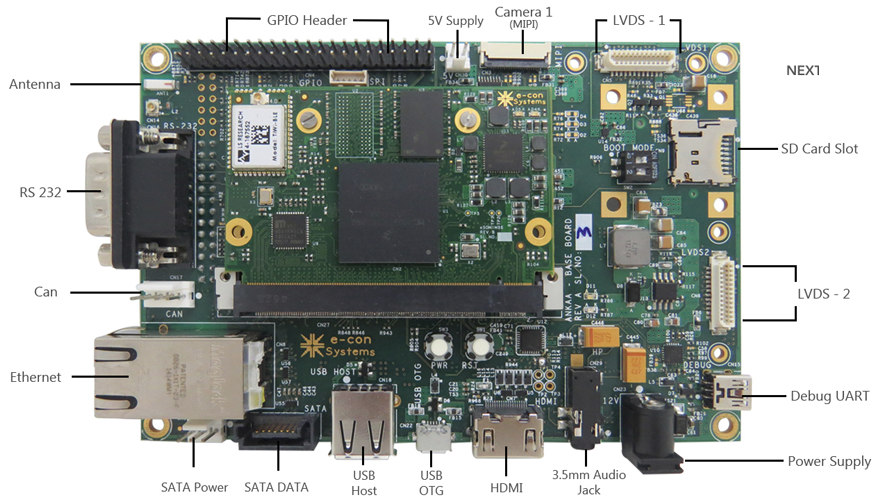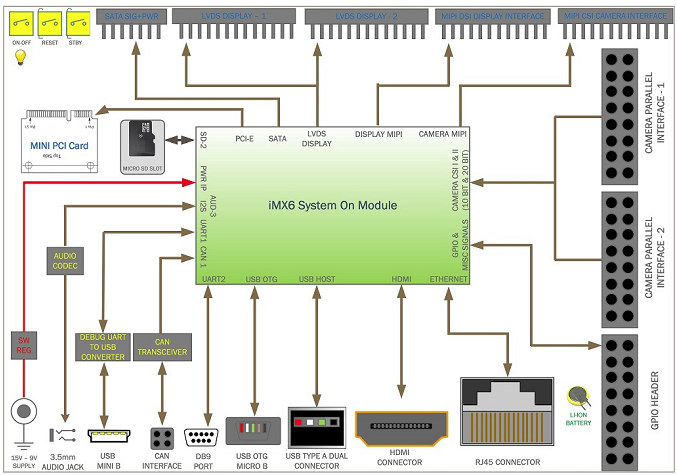QSeven is one of the many standards for system-on-modules, and it defines both Qseven (Q7) 70x70mm modules, and smaller μQSeven (μQ7) 70x40mm modules. While there are quite a few SoMs following the larger form factor, few modules are based on micro Q7, and e-con Systems eSOMiMX6 has just launched one of these tiny modules with eSOMiMX6 system-on-module powered by Freescale i.MX6 processors, as well the corresponding Ankaa development kit comprised of the SoM and a baseboard.
eSOMiMX6 module specifications:
- SoC – Freescale i.MX6 single, dual or quad Cortex A9 processor @ 800MHz to 1.2 GHz with Vivante GPUs
- System Memory – 256MB/512MB (Solo only), 1GB (default), or 2GB (dual/quad only) LVDDR3 RAM
- Storage – 4GB (default) to 64GB eMMC flash, 2MB SPI NOR flash, and SD/MMC + SATA II interfaces via MXM connector
- Display / Video Output:
- HDMI up to 1920 x 1080
- Dual channel 24-bit LVDS
- 24-bit LCD RGB
- MIPI DSI
- Camera:
- 4-lane MIPI-CSI (2-lane for Solo)
- 10 bit parallel camera I/F
- 20-bit parallel camera I/F
- Connectivity – Optional Gigabit Ethernet controller, optional module for 802.11 b/g/n Wi-Fi and Bluetooth 4.0 BLE
- Other I/O accessible via 314-pin MXM connector:
- USB 2.0 host, USB 2.0 OTG
- SPDIF audio in and out
- 2x CAN (FlexCAN)
- 5x serial UART
- 3x I2C, 3x PWM, SPI
- Up to 50x GPIOs
- PCIe x1 Gen2
- Power Supply – 3.3V @ 3A
- Dimensions – 70 x 45mm
- Temperature Range – Commercial: 0 to 70°C; or Extended: -40 to 85°C
You may have noticed the module size is 70x45mm, and not 70×40 as in Q7 specifications, which is probably why the companies refers to a custom μQseven” form-factor, where they’ve kept the MXM connector, the same mounting holes position, but increased the width of the board. So it should still work with most Q7 baseboards, unless the 5 millimeters extra interfere with your baseboard.
The company provides BSPs for Linux (with bootloader), and Android, with Windows Embedded Compact (WEC) 2013 still in development.

To speed up development, e-con Systems can also provide Ankaa development kit with including eSOMiMX6 Module (eSOMiMX6-CS-P1G-F4G-R1G-WB-E with i,MX6 Solo @ 1GHz, 1GB RAM, 4GB eMMC, Wi-Fi/BT, and Ethernet), Ankaa carrier board, and HDMI cable, a USB to serial port cable, and a 9V power supply. They have both Linux and Android version of the kit, and the latter also adds a 10″ LCD with capacitive touch.
Ports and features available on Ankaa development kit:
- 314-pin MXM connector for uQ7 SoM
- Storage – SATA connectors (DATA + Power, not working with Solo SoM), SD Card slot
- Camera – MIPI – 4 lane interface; Parallel interface 1 – 10 bit; Parallel interface 2 – 20 bit (Quad processor only) with 5MP, 8MP and 13MP MIPI Cameras available as add on boards.
- Display – 1x HDMI, 2x LVDS
- Audio – 3.5mm audio jack
- Connectivity – WIFI 802.11 b/g/n & Bluetooth 4.0 BLE (on SoM), 1x Gigabit Ethernet
- Serial Ports – 1x RS232, 1x Debug Port (serial console) via mini USB port.
- USB – 1x USB Host (2.0), 1x micro USB OTG (2.0), 1x mini USB debug port (UART)
- Expansion
- GPIO header with access to GPIOs, I2C, SPI, etc…
- CAN header
- mini PCIe slot
- Misc – Boot selection switch, RTC + battery
- Dimension – 135mm (L) x 90mm (B)
- Power Supply – 9V @ 2.5A; 5V supply also available via header
- Temperature Range – – 0°C to 70°C

eSOMiMX6 module price starts at $47 for 1,000+ unit orders for the Solo version, and up to $199 for the extended temperature range quad core version will all options, in 1-99 units orders. Ankaa kits sells for $349 for the Linux version, and $449 for the Android version with LCD display. Price for the Android kit is only valid until the end of the year, after which it should cost $674. The camera add-on boards sell between $69 to $99. Further details can be found on eSOMiMX6 modules and Ankaa devkit product pages, and you can purchase SoM samples, Ankaa devkit, and/or the camera modules via e-con Systems Webstore.
Via Embedded.com and LinuxGizmos

Jean-Luc started CNX Software in 2010 as a part-time endeavor, before quitting his job as a software engineering manager, and starting to write daily news, and reviews full time later in 2011.
Support CNX Software! Donate via cryptocurrencies, become a Patron on Patreon, or purchase goods on Amazon or Aliexpress





